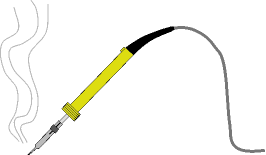Home |
Map |
Projects |
Construction |
Soldering |
Study |
Components |
555 |
Symbols |
FAQ |
Links

Ohm's Law
Next Page: Power and Energy
Also See: Voltage and Current | Resistance |
Resistors
To make a current flow through a resistance there must be a voltage across that resistance.
Ohm's Law shows the relationship between the voltage (V), current (I) and resistance (R).
It can be written in three ways:
| where: |
V = voltage in volts (V)
I = current in amps (A)
R = resistance in ohms ( ) ) |
or: |
V = voltage in volts (V)
I = current in milliamps (mA)
R = resistance in kilohms (k ) ) |
For most electronic circuits the amp is too large and the ohm is too small,
so we often measure current in milliamps (mA) and resistance in kilohms
(k ).
1 mA = 0.001 A and 1 k
).
1 mA = 0.001 A and 1 k = 1000
= 1000  .
.
The Ohm's Law equations work if you use V, A and
 ,
or if you use V, mA and
k
,
or if you use V, mA and
k .
You must not mix these sets of units in the equations so you may need to convert between
mA and A or k
.
You must not mix these sets of units in the equations so you may need to convert between
mA and A or k and
and
 .
.
The VIR triangle
You can use the VIR triangle to help you remember the three versions of Ohm's Law.
Write down V, I and R in a triangle like the one in the yellow box on the right.
- To calculate voltage, V: put your finger over V,
this leaves you with I R, so the equation is V = I × R
- To calculate current, I: put your finger over I,
this leaves you with V over R, so the equation is I = V/R
- To calculate resistance, R: put your finger over R,
this leaves you with V over I, so the equation is R = V/I
Ohm's Law Calculations
Use this method to guide you through calculations:
- Write down the Values, converting units if necessary.
- Select the Equation you need (use the VIR triangle).
- Put the Numbers into the equation and calculate the answer.
It should be Very Easy Now!
- 3 V is applied across a 6
 resistor, what is the current?
resistor, what is the current?
- Values: V = 3 V, I = ?, R = 6

- Equation: I = V/R
- Numbers: Current, I = 3/6 = 0.5 A
- A lamp connected to a 6 V battery passes a current of 60 mA, what is the lamp's resistance?
- Values: V = 6 V, I = 60 mA, R = ?
- Equation: R = V/I
- Numbers: Resistance, R = 6/60 = 0.1
k
 = 100
= 100 
(using mA for current means the calculation gives the resistance in
k )
)
- A 1.2 k
 resistor passes a current of 0.2 A, what is the voltage across it?
resistor passes a current of 0.2 A, what is the voltage across it?
- Values: V = ?, I = 0.2 A, R = 1.2 k
 = 1200
= 1200 
(1.2 k is converted to 1200
is converted to 1200  because A and k
because A and k must not be used together)
must not be used together)
- Equation: V = I × R
- Numbers: V = 0.2 × 1200 = 240 V
Next Page: Power and Energy
| Studying Electronics
© VCampus 2013, The Electronics Club,
vcampus.co

![]() ,
or if you use V, mA and
k
,
or if you use V, mA and
k![]() .
You must not mix these sets of units in the equations so you may need to convert between
mA and A or k
.
You must not mix these sets of units in the equations so you may need to convert between
mA and A or k![]() and
and
![]() .
.
